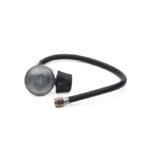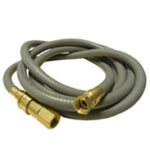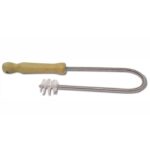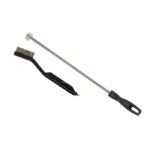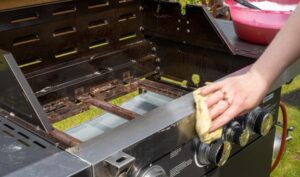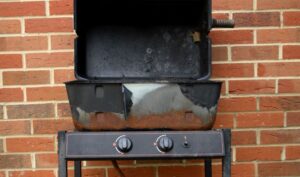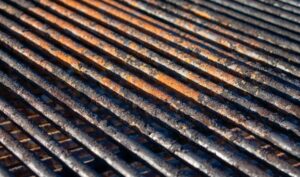The Complete Guide to Troubleshooting Gas Grill Issues is your source for step-by-step instructions on how to diagnose and fix the most common gas grill issues. Whether your grill isn’t heating properly, won’t stay lit, or simply has rusty parts, we’ve got the answers you need to get your gas barbecue firing on all cylinders.
Few things are more disappointing than having everything prepped and ready for a BBQ, only to turn on your grill and discover that your gas grill is not getting any gas.
If natural gas or propane is not flowing to your grill, there could be several reasons why your gas grill won’t light:
- There’s no gas in the tank
- The barbecue is in bypass mode
- There’s a gas leak
- There’s a blockage or burner misalignment
In this section of the Complete Guide to Troubleshooting Gas Grill Issues, we’ll explore four of the most common reasons why your gas grill is not getting gas and how to fix them. Let’s get cooking.
4 Reasons Your Gas Grill Is Not Getting Gas
1. There’s no gas in the tank
If your igniter is working but your gas grill won’t light, check if your propane tank is full. To confirm that the fuel gauge is correct, place the tank on a weight scale. A standard 20 pound tank will weigh between 37-38 pounds when full. An empty tank will weigh closer to 18 pounds.
2. Your barbecue is in bypass mode
If the igniter is working and there’s gas in the tank (or you have a natural gas grill) but your gas grill still won’t light or get up to temperature, your barbecue may be in bypass mode.
All gas grill regulators are equipped with a safety device called a “flow-limiting device”, or “Overfill Protection Device” (OPD). This flow-limiting device automatically triggers when it detects a gas leak (or what it thinks is a gas leak), reducing the gas flow to 10% or less than its standard volume. This prevents the grill from becoming dangerously overfilled with gas.
GRILL SPOT TIP: Bypass mode can be triggered by mistake from something as simple as turning on the control knobs before you turn on the propane tank valve.
If your grill is showing signs of being in bypass mode, such as not lighting or not getting up to temperature (grills in bypass mode max out at 250-300 degrees) the first thing to do is perform a gas leak test (see next section), since that’s the problem this safety device is designed to take care of.
If there are no gas leaks, your next step is to reset the gas grill regulator. Resetting the gas grill regulator OPD is simple. Follow these steps:
- Open the grill lid.
- Turn off the gas at the propane tank and disconnect the gas line from the tank,
- Turn all the control knobs up to high, including any side burners.
- Wait for one full minute, then turn the control knobs off.
- Reconnect the regulator to the propane tank.
- Slowly turn the gas on at the tank.
- Light your grill as normal.
3. There’s a gas leak
If natural gas or propane is still not flowing to your grill, you may have a gas leak. Gas leaks can be caused by something as simple as a loose connection or a damaged gas hose. To check your grill for gas leaks, follow these easy steps:
- Mix a 50/50 solution of soap and water.
- Brush the solution onto your gas hose and any connection points.
- Open your gas supply. If there are leaks, you will see bubbles forming at the source of the leak.
- Close the gas supply.
If you see bubbles, see if you can determine where they are coming from:
- If you see bubbles coming from a connection point, disconnect and reconnect your hose. Run the test again. If you still see bubbles, tighten the gas hose and regulator.
- If they are coming from the hose, replace the hose.
Shop for replacement hoses:
4. There’s a blockage or burner misalignment
If there is food debris blocking the burners or your burners aren’t properly aligned, your grill may not be getting enough gas. Check your burners for misalignment and obstruction. The burner tube should be properly seated on the gas valve, with the valve sitting inside the opening of the burner.
If the alignment looks good, clean the venturi tubes and burner port holes to ensure there’s no debris blocking the gas:
- Remove the burners and use a bottle brush or special venturi brush to clean out the venturi tube of each burner.
- Use a wire brush or other needle-like object to remove any deposits from each clogged port and restore normal gas flow.
Conclusion
There could be a few different reasons why your propane or natural gas grill is not getting gas. Thankfully, all of the reasons have very easy fixes you can handle at home by:
- Refilling the propane tank
- Getting your grill out of bypass mode
- Repairing a gas leak
- Cleaning out a burner blockage or misalignment
Still having trouble getting your grill up to temp? Keep reading: Why Is My BBQ Not Getting Hot Enough? How To Diagnose and Fix Gas Grill Temperature Problems
Still struggling with your grill? Learn more about different grill problems, what causes them, and how to solve them in our Complete Guide to Troubleshooting Gas Grill Issues.


